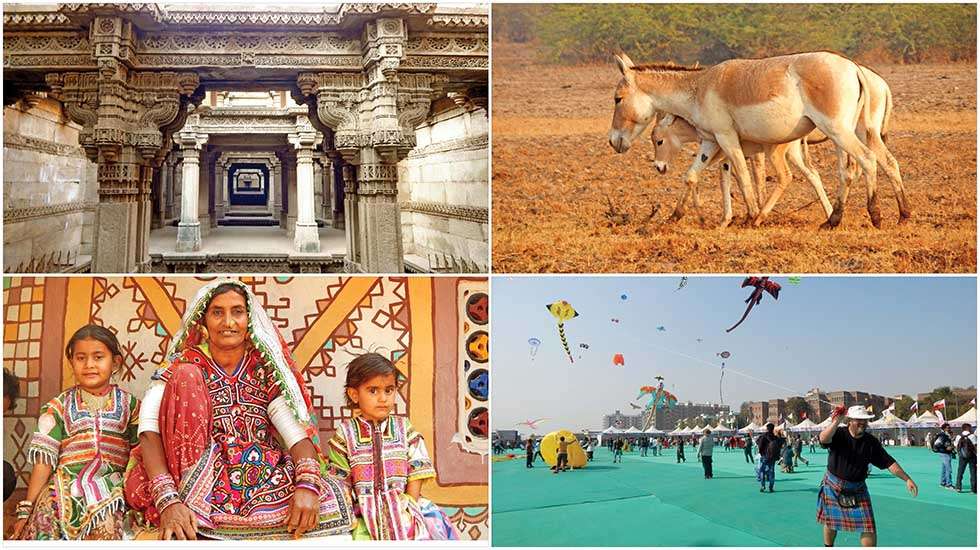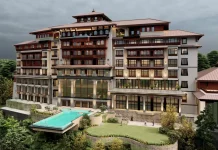With deserts, beaches, hills, pilgrimage hotspots, wildlife sanctuaries, world heritage sites, rich history and culture and a host of festivals, there’s probably no other Indian state that is as diverse and dynamic as Gujarat.
Text and photographs by Namita Gupta
[wzslider autoplay=”true” transition=”‘flash'” lightbox=”true” exclude=”116735″]
When Amitabh Bachchan tells you Breathe in a bit of Gujarat or Kuch Din to Guzaro Gujarat Mein in the Khushboo Gujarat Ki campaign by Gujarat Tourism, he means it and you will too when you visit the gorgeous state of Gujarat. The choices are endless and with Kite Tourism, Border Tourism, Wellness Tourism, Spiritual Tourism, Religious Tourism, Wildlife Tourism, Golf Tourism, Cinematic Tourism and so much more, sky is the limit to what you can see and do during your stay in Gujarat.
Ahmedabad: UNESCO World Heritage City – If Gandhinagar is the capital of Gujarat, Ahmedabad is its heart. Plonked in the heart of the state, this city never ceases to amaze and enliven your senses. More than 600 years old, this walled city of Ahmedabad on the eastern bank of the Sabarmati river, founded by Ahmed Shah was recently declared India’s first World Heritage City and aren’t we proud of it. The city presents a rich architectural heritage from the Sultanate period and still retains much of its old world charm so evocative of Ahmedabad, with a good blend of modern development and infrastructure.
The NID Ground at Sabarmati Riverfront in Ahmedabad came alive with thousands of kites at the 29th International Kite Festival – IKF 2018 from January 7 to 14, 2018. Vibrant hues and eye-catching and innovative kites took to the skies, signifying unity in diversity, filling the venue with a festive mood from dawn till dusk. Watching not just Gujaratis but people from across the world come together to lift their kites aloft and watch them soar high during Uttarayan, Makar Sankranti, or Kite Festival is a treat for sore eyes. Food and Craft Bazaar and cultural dances added to the fervor of IKF.
Sabarmati Ashram – The moment you step into the home of Gandhi, where he lived from 1917 until 1930 with his wife Kasturba, you’re filled with a sense of unflappable poise and calm. The peaceful retreat on the banks of the River Sabarmati away from the bustling city life takes you back in time when the Mahatma’s peaceful protest brought an end to the colonial rule in India. He also started the famous Dandi or Salt March from Sabarmati Ashram. There’s also a museum here where you can see his books, life size artworks, photographs of the Mahatma with his wife, and actual relics like his writing desk and the spinning wheel.
Adalaj Stepwell – An Indo-Islamic architectural marvel in the village of Adalaj in Gandhinagar. Step five storey’s down the stairs on three sides descending into an octagonal opening supported on eight pillars. Rana Veer Singh of the Vaghela dynasty of Dandai Desh started the construction and after he was killed, his wife Rani Rudabai agreed to Mahmud Begada’s marriage proposal on the precondition that he would complete making the stepwell. The Rani decided to end her life after the completion of the stepwell or vav (in Gujarati). Look out for intricate carvings in this water building that was built to collect rain water with water of life and tree of life scenes, female dancers and musicians, sculptures of a king, two chauri-bearers in attendance, scenes depicting churning of buttermilk, birds and animals and more.
Sarkhej Roza, Sidi Saiyyed Mosque and Jama Mosque – A unique Indo-Saracenic architectural style, you will see a fusion of Islamic influences from Persia with indigenous Hindu and Jain features at Sarkhej Roza. The intricately carved jaalis, jharonkhas, arches and domes add to the magnificence of the place. On the day we stopped by at the Roza Complex at Sarkhej, built at the advent of Sultanate era by Mohammad Shah, and completed by Qutb’ud-Din Ahmed Shah and Mahmud Begada, there was a Muslim mass marriage going on and needless to say it was very crowded. If you don’t have much time at hand, do stop by at the Sidi Saiyyed Mosque also for a quick look at the famous Tree of Life Jaali or latticework on the semi-circular arched windows. Go back in time at Jama Masjid in the old walled city where the tombs of Sultan Ahmed Shah, his son, Mohammed Shah and his grandson, Qutub-Ud-Din Ahmed Shah 2nd are located.
Beautiful Bhuj: Village hopping in quest for art and craft – From Ahmedabad drive 350 km to reach Bhuj, famous for several handicrafts villages – Gandhi nu gaam, Bhujodi, Hodka, Dhamadka, Ludiya and Khavda. Kutch is the Mecca of the vibrant Kutchi handicrafts and the entire families from grandparents to grandchildren can be spotted engrossed in embroidery work. The skills of these traditional handicrafts have been passed down from generation to generation. Ludiya might seem like a staid hamlet at first sight, but this humble village near Bhuj in Banni district of Kutch is home to some of the most talented craftswomen adept at Kutchi embroidery, accessories, terracotta pottery, lacquerware, and home decor. The Khatri family at Nirona village is taking the legacy of Rogan Art forward. The humble village earned its share of fame when our Prime Minister Narendra Modi gifted a Rogan Art painting created by Abdulgafur D Khatri to US President Barack Obama in 2014. The art originated from Persia and Pakistan 300 years ago and is practiced only by Gafurbhai’s family on bags, wall hangings, sarees, dress materials, jackets and stoles. Besides the colour pigments, castor oil is used and requires a unique technique of handcrafting each of the breathtaking pieces.
On our drive we saw endless plantations of castor bean plants flanking the highway, from which they extract the castor oil to make Rogan Art. Also take a lesson or two in Copper Bell Art making from the Luhar family. Husen Luhar has been handcrafting these copper bells all his life and till today at the age of 70, he’s going strong; beating iron into the shape of a bell, joining the ends, coating each of them and then burning it in a woodfire place with a mud casing, resulting in a beautiful copper bell. His entire family assists him in this step-by-step process that is a marvel to watch. You can also visit Dhamadka village to watch and learn the interesting process of block printing.
Nothing short of a dream: Rann of Kutch – On your drive from Bhuj to Dhordo to reach the Rann of Kutch you will pass through the spot where the Tropic of Cancer passes through. Because of Dhordo’s close proximity to Pakistan, a permit is required to enter the area, which is available easily. The mere mention of Rann of Kutch conjures one of two things, desert and salt, or even both together. One of the most stunning sights has to be the vast expanse of pristine white sand marshes in the Little Rann of Kutch, nature’s own work of art. The best time to visit the Rann of Kutch is during full moon as the moonlight on mystical white sands makes it all the more alluring. It is breathtaking to say the least. Stay at the Rann Utsav, Tent City for an experience of a lifetime. You can experience India’s biggest White Rann Desert Festival at Tent City which hosts cultural dances and shows every evening post a lavish traditional Gujarati buffet dinner. Now you know – Kutch nahin dekha toh kuch nahi dekha!
Wildlife at its best: Wild Ass Sanctuary – Open up a bagful of surprises at the Rann of Kutch. We stayed at the Royal Safari Camp, Bajana and drove to the Wild Ass Sanctuary, before sunrise to catch the last population of the Asiatic wild ass roaming free in the cold, arid deserts. It also a birdwatcher’s paradise. This Galloping Pride of the Rann is also a wetland site of international importance with birds like Greater Flamingo, Lesser Flamingo, White Pelican, Dalmation Pelican, Great Crested Grebe and Caspian Tern, besides Falcons, Harriers, Houbara Bustard and more inhabiting it. Being up, close and personal with the endangered and endemic wild ass, a member of the horse family called Equidae is an experience in itself.
Food chronicles – They might sound like tongue twisters but they’re a must-try on every foodies to-do list. Tuck in some fafda, khakra, thepla, khandvi, handvo, sukhdi, panki, khichu, thalipith and dhokla and you won’t be disappointed. A stopover at SaasuJi Dining Hall in Ahmedabad is a must for its mouth-watering and wholesome thali filled with shahi dhokla, patra, methi papad, paneer pasanda, undhiyu, bataka tameta, bajra na rotla, sitafal basundi and malpua. For your fix of the best of authentic Gujarati snacks also head to Swati Snacks and bite into some flavourful satpadi roti with gatta nu shak. On your highway drive do look out for Chamunda Krupa Restaurant, Maraj that serves a delicious Gujarati thali, fit for the royals. We head back home with memories of soul-satisfying food, precious moments of walking on white sands under the moonlit sky, bagful of shopping from the famous Law Garden and various handicraft villages and promises to ourselves to come back for more.












 Raashii Khanna
Raashii Khanna










